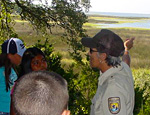
Refuge interpretation programs provide opportunities for visitors to make their own connections to the natural world. From self-guided walks to Ranger-led programs, we help visitors learn more about the wildlife and habitat behind the landscapes.
In addition to staff and volunteers presenting programs to audiences, we provide a variety of wayside signs, brochures, and webpages to communicate natural history stories to visitors. Printed and virtual information is often available on many topics, including plants and animals, seasonal migrations, habitats, refuge management strategies, and endangered species.
Through our interpretation programs, you can learn why nearly all of the critically endangered Whooping Cranes spend the winter at St Mark's National Wildlife Refuge in Florida, or about the beneficial role of fire to encourage native vegetation to grow at Lower Suwannee NWR, and other interesting and informative stories.